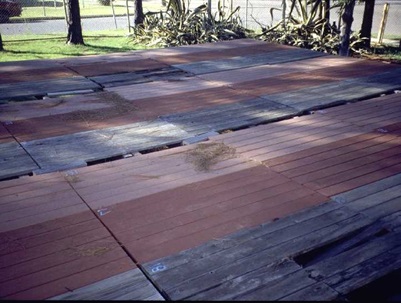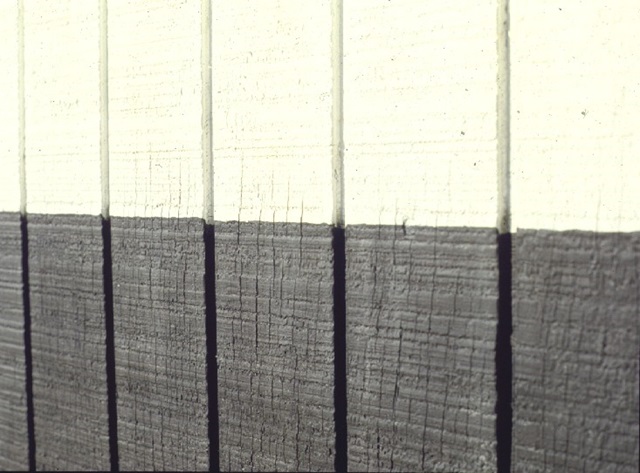Choosing the correct exterior timber finish
posted: 17/Aug/2015

All timber, (irrespective of species, durability classification, or whether it is preservative treated or not) will undergo changes when exposed to the sun and rain. Ultraviolet light and changes in moisture will cause timber to “weather”. It will lose its natural colour and fade to a silver/grey, its surface will become rough, and splits and cracks could develop.
Weathering primarily affects the appearance of timber, however in the long term could affect durability and performance. Varying degrees of protection from weathering may be provided by the application of coatings such as paints, water repellents, water repellent preservatives and pigmented penetrating stains.
It is important to note that preservatives used to increase durability (protection from decay and/or insects) do not permanently prevent timber from weathering.
The application and regular maintenance of coatings will reduce weathering. Proper finishing also helps external timber fulfill its designed function.
To protect from rapid moisture content changes, finishes form a barrier between the weather and the timber, reducing water absorption on wetting, and slowing moisture loss on drying.
To protect from UV light, finishes generally should contain a pigment (light colours preferred). The pigment reflects or absorbs the UV light, and shields the timber.
Types of Finishes
Many protective finishes are commercially available. They range from clear water repellent resins and penetrating oils, through stains, to full paint systems. There are major differences between them in their appearance, cost, ease of application, ease of maintenance, degree of protection offered and frequency of re-application.
When choosing a finish it is generally a matter of deciding on an appropriate balance between maximum service life (frequency of maintenance) and maximum ‘naturalness’ in its appearance.

The following will help with that choice:-
Paints
Maximum protection from the effect of the environment is provided by the traditional paint systems which form surface films. Thousands of old homes with timber cladding in perfect condition after one hundred years service stand in testimony to the protective qualities of paint films.
The disadvantages of paints are that they obscure the timber colour and grain, and they require surface preparation prior to re-coating.
Paint systems give the longest interval between re-coats. Up to ten years can be expected from top quality systems.
Dark colours absorb more solar radiation than light colours, and deteriorate faster in service. White pigments reflect the maximum amount of ultraviolet light possible, and provide the best protection to both the timber and paint film.

Light = GOOD Dark = BAD
Solvent borne (alkyd or oil) finishes are more resistant to water vapour than water borne (acrylic) finishes. Where a high level of protection is required, a finish system with a solvent borne primer and/or undercoat should be selected.
Acrylic (water based) paints have been vastly improved in recent years and now offer service lives comparable with alkyd resin (oil or solvent based) paints. They are somewhat easier to apply but their softer films tend to retain more dirt than alkyd (solvent based) paints, and thus can harbour more mould growth.
Clear Finishes
Being transparent to light, clear finishes allow the full beauty of the timber to be seen, but where exposed to sunlight they also allow UV damage, with consequent fading and surface roughening.
Water repellent preservatives (WRP) are useful in temporarily protecting certain timber species which have marginal durability for exterior use. They contain water repellent resins and waxes which penetrate about 1-2 mm into the wood to form a water barrier. They may also contain a wood preservative fungicide such as copper naphthenate, zinc naphthenate or TCMTB, or an insecticide such as permethrin. While this barrier is intact, the timber is protected from rapid moisture content changes. However, the resins and waxes are degraded by atmospheric oxidation (accelerated by the action of sunlight), and usually are effective for periods of six to 18 months, depending on the degree of weather exposure. Re-application however is a simple procedure, involving a minimum of surface preparation.
Most clear film type finishes (varnishes, clear polyurethanes, epoxies etc.) generally give insufficient service life to recommend them for external use. However, water based and solvent (oil) based clear finishes, with UV absorber additives are available, which can provide good protection as long as they are regularly maintained.
Stains
An attractive natural appearance may be achieved using penetrating stains. They allow the grain and texture of the timber to be seen, and are available in a wide range of colours to match or change the original colour of the timber species in use (pale colours preferred).
Stains contain dyes or pigments which minimise the effects of UV light. They offer greater protection and a longer maintenance interval than clear finishes, providing they also contain some water repellent compounds. Both water based and solvent based stain formulations are available. Water based stains are generally cheaper, but do not penetrate as well as those based on light oil or organic solvents.
Penetrating stains which do not build up a surface film are easy to maintain. When they lose their effectiveness (after about two to four years, depending on exposure), a simple washing of the surface is all that is necessary before re-application.
Previous Articles
Do you know your timber truss history?
If you want a long lasting timber deck you need to consider moisture content and expansion.
The excitement of getting a beautiful timber floor can easily turn to despair if moisture conditions are not taken into consideration.